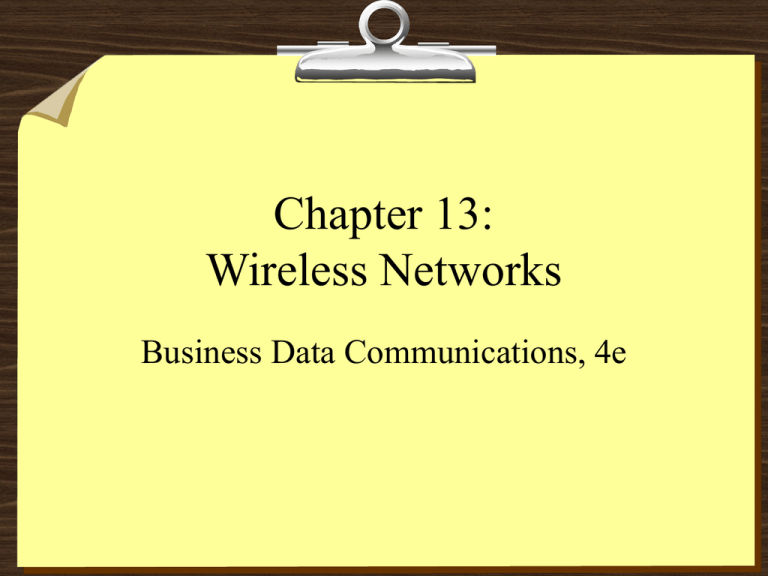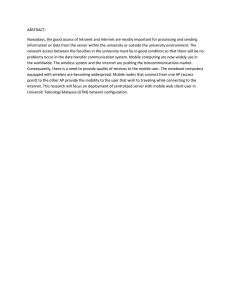Chapter 13: Wireless Networks Business Data Communications, 4e
advertisement

Chapter 13: Wireless Networks Business Data Communications, 4e Reasons for Wireless Networks Mobile communication is needed. Communication must take place in a terrain that makes wired communication difficult or impossible. A communication system must be deployed quickly. Communication facilities must be installed at low initial cost. Problems with Wireless Networks Operates in a less controlled environment, so is more susceptible to interference, signal loss, noise, and eavesdropping. Generally, wireless facilities have lower data rates than guided facilities. Frequencies can be more easily reused with guided media than with wireless media. Mobile Telephony First Generation analog voice communication using frequency modulation. Second Generation digital techniques and time-division multiple access (TDMA) or code-division multiple access (CDMA) Third Generation evolving from second-generation wireless Advanced Mobile Phone Service AMPS Components Mobile Units contains a modem that can switch between many frequencies 3 identification numbers: electronic serial number, system ID number, mobile ID number Base Transceiver full-duplex communication with the mobile Mobile Switching Center Global System for Mobile Communication Developed to provide common 2ndgeneration technology for Europe 200 million customers worldwide, almost 5 million in the North America GSM transmission is encrypted Spectral allocation: 25 MHz for base transmission (935–960 MHz), 25 MHz for mobile transmission (890–915 MHz) GSM Layout Multiple Access Four ways to divide the spectrum among active users frequency-division multiplexing (FDM) time-division multiplexing (TDM) code-division multiplexing (CDM) space-division multiplexing (SDM) Choice of Access Methods FDM, used in 1st generation systems, wastes spectrum Debate over TDMA vs CDMA for 2nd generation TDMA advocates argue there is more successful experience with TDMA. CDMA proponents argue that CDMA offers additional features as well, such as increased range. TDMA systems have achieved an early lead in actual implementations CDMA seems to be the access method of choice for third- Third Generation Systems Intended to provide provide high speed wireless communications for multimedia, data, and video Personal communications services (PCSs) and personal communication networks (PCNs) are objectives for third-generation wireless. Planned technology is digital using TDMA or Wireless Application Protocol (WAP) Programming model based on the WWW Programming Model Wireless Markup Language, adhering to XML Specification of a small browser suitable for a mobile, wireless terminal A lightweight communications protocol stack A framework for wireless telephony WAP Programming Model WAP Protocol Stack Wireless Telephony Applications: A Sample Configuration Geostationary Satellites Circular orbit 35,838 km above the earth’s surface rotates in the equatorial plane of the earth at exactly the same angular speed as the earth will remain above the same spot on the equator as the earth rotates. Advantages of Geostationary Orbits Satellite is stationary relative to the earth, so no frequency changes due to the relative motion of the satellite and antennas on earth (Doppler effect). Tracking of the satellite by its earth stations is simplified. One satellite can communicate with roughly a fourth of the earth; three satellites separated by 120° cover most of the inhabited portions of the Problems with Geostationary Orbits Signal can weaken after traveling > 35,000 km Polar regions and the far northern and southern hemispheres are poorly served Even at speed of light, about 300,000 km/sec, the delay in sending a signal from a point on the equator beneath the satellite 35,838 km to the satellite and LEO and MEO Orbits Alternatives to geostationary orbits LEO: Low earth orbiting MEO: Medium earth orbiting Satellite Orbits Types of LEOs Little LEOs: Intended to work at communication frequencies below1 GHz using no more than 5 MHz of bandwidth and supporting data rates up to 10 kbps Big LEOs: Work at frequencies above 1 GHz and supporting data rates up to a few megabits per second


